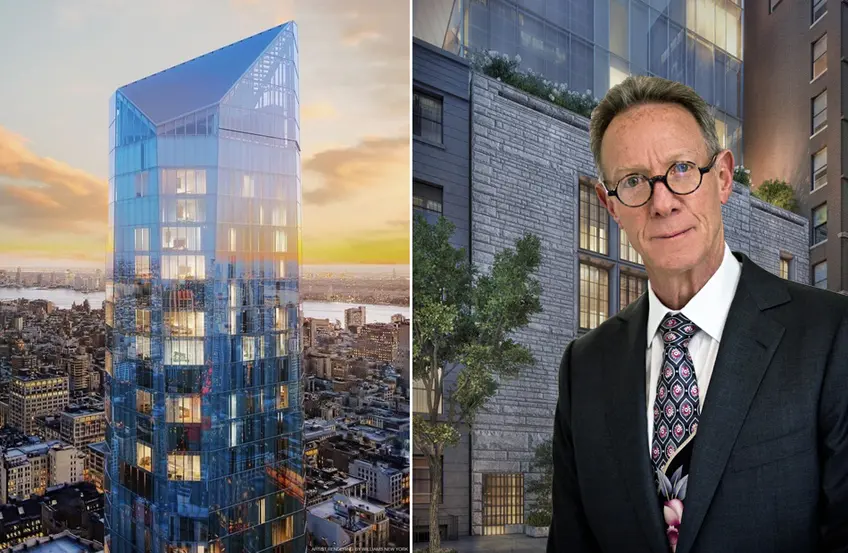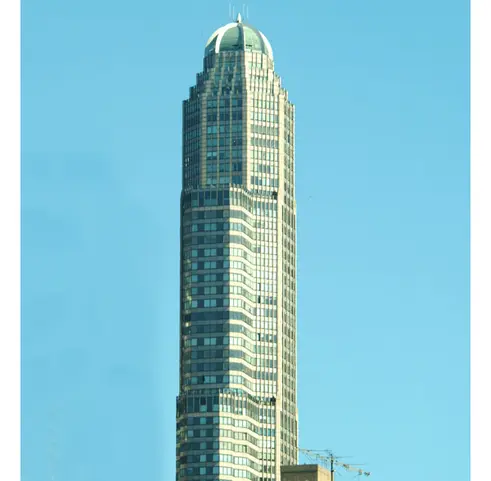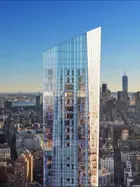 Bruce Eichner and his latest development, Madison Square Park Tower (Renderings by Williams New York)
Bruce Eichner and his latest development, Madison Square Park Tower (Renderings by Williams New York)
Bruce Eichner, the founder of The Continuum Company, is a super nice guy...which is not at all what you might expect from a New York City developer who has been in the business for almost 40 years and been through the wringer. Since the 1980s, Eichner has seen transformations in almost every aspect of the city and the building industry. His most recent project, Madison Square Park Tower at 45 East 22nd Street will be the tallest and, considered by many, the most iconic building in the Flatiron District. The Kohn Peterson Fox-designed 65-story, glass tower that rises 777 feet into the sky from it’s elegant, traditional granite base nods to the neighborhood’s past and future.
CityRealty spoke to Eichner to find out how Madison Square Park Tower stands above the rest, what changes he has seen in his four decades in the business, and where his very exciting new Crown Heights Brooklyn vision to develop feasible workforce housing paradigm will take him.
CityRealty spoke to Eichner to find out how Madison Square Park Tower stands above the rest, what changes he has seen in his four decades in the business, and where his very exciting new Crown Heights Brooklyn vision to develop feasible workforce housing paradigm will take him.
How has the high-end New York market changed since you have been in the industry?
Eichner: I could give you half a dozen answers to that.
The first thing is that 40 years ago, you didn’t have starchitects. If you look at the different buildings built in the 1980s, by in large, they were done by residential architects. You didn’t have the kind of design associated with luxury condominiums.
The second thing is that you absolutely did not have a plethora of interior design firms of such international notoriety.
Third, the level and scope of amenities packages bear no relationship to 30 to 40 years. 30 to 40 years ago, “an over the top amenity” was a swimming pool.
The fourth thing that really changed is the quality and expansiveness of building materials. You used to go to Kohler, not that there’s anything wrong with Kohler, but now you have custom hardware companies. You’ve got nine different kinds of woods you've never seen before. Wood used to come in narrow planks, maybe herringbone, and now it’s engineered hardwood six inch wide planks. You’re talking about one kind of esoteric finish after another. Everyone competes with who is the kitchen manufacture to the stars. The building's materials and finishes are radically different.
In this article:
“The level and scope of amenities packages bear no relationship to 30 to 40 years. 30 to 40 years ago, 'an over the top amenity' was a swimming pool.”
Another thing that is quite different is the level of technology. We didn’t have CAD drawings. You didn't have the ability to coordinate mechanical systems and now you can sit in the room, put it up on a screen and look at what it will look like.
The next most significant change has been the impact on the outer boroughs. You didn’t have a downtown waterfront in Williamsburg. You didn’t have a downtown Brooklyn, no Long Island City. There was no development there. If you told someone there would be condominium on Brooklyn waterfront that would sell for $1,400 a square foot, they would have committed you to a psychiatric ward immediately. Residential development has really impacted the face of the city.
The next most significant change has been the impact on the outer boroughs. You didn’t have a downtown waterfront in Williamsburg. You didn’t have a downtown Brooklyn, no Long Island City. There was no development there. If you told someone there would be condominium on Brooklyn waterfront that would sell for $1,400 a square foot, they would have committed you to a psychiatric ward immediately. Residential development has really impacted the face of the city.
What are some changes for the better and worse?
Eichner: On the better side, you have way more quality apartments than ever existed before. You have way more buildings that have crazy kinds of views that never existed before. For the residents, you have a combination of amenities and finishes that are quite unique. When you compare an apartment from the 1980s to now, everything from the ceiling heights, finishes, quality of windows, etc. is absolutely demonstrably better.
On the negative side, the cost of land has skyrocketed, the cost of construction skyrocketed, and there's a lot more, if not too many, expensive apartments. One of the main reasons there is such a thriving Brooklyn and Long Island City market is because people got priced-out of areas. There is a lot less affordability, and the ability of working-class people to find homes is virtually nonexistent. That is not good.
What are some new challenges in the market?
Eichner: There is absolutely an over-saturation in the luxury market. That’s the combination of the fact that there are no barriers to entry and new marketing ideas.
You have had a number of people who may or may not be experienced in building in tertiary locations. You have a ton of stuff in Tribeca and Soho that are smallish buildings they have no views, no amenities, no parking, they are just in an “A” location. They’re typically smaller buildings with a smaller number of larger apartments. I don’t know who is buying those.
Regarding the marketing ideas, for 22nd Street, in two years I have only run two ads. The entirety of the building was marketed using social media (it is 80% sold). I haven’t run an ad in two and a half years. If I were the New York Times, I would be concerned at some point at what the reliable frequency for full page ad for residential properties will be in 10 years.
What makes Madison Square Park Tower stand out in this over-saturated market?
Eichner: When you juxtapose Madison Square Park Tower on the screen against other buildings, there are four things that resonate with buyers.
First are our exceptional views. People pick their neighborhood then consider the views. The reason the Flatiron district has become the neighborhood it is, is because Madison Square Park has become one of the most used green spaces in the city. You take that, the ease of transportation and the fact that it’s right in between Midtown and SoHo and Tribeca.
So you got the views, you got the neighborhood, then you get the significance of amenities and having first five floors of the building being amenities that include a bi-level library, fitness center, simulator room (I think we have the only simulator room in the city where you can go either play golf or you play virtual basketball or go shooting - not that that’s popular - or hockey), a children’s playroom, basketball court, 5th floor residence lounge, billiards room, card table, and outdoor terrace. There are only 82 apartments in the building.
“If you are on the lowest floor in the building with minimal views, you can call the concierge, book a Saturday night and enjoy the same views and the same space as the guy who paid $20 million for the penthouse.”
The thing I really think is the big selling point is that I took the 54th floor and converted it into a spectacular space with almost 360-degree views of entertainment space that all the residents can use. You can call concierge, use the dining and lounge area, demo kitchen, separate catering kitchen and cocktail bar. If you are on the lowest floor in the building with minimal views, you can call the concierge, book a Saturday night and enjoy the same views and the same space as the guy who paid $20 million for the penthouse.
I had interior designer Martin Brudnizki, the preeminent London space hospitality advisor who had never done a luxury condominium, develop something unique. I think that’s what people have reacted very positively to.
The bottom of the building is elegant granite which really fits into the neighborhood, unlike One Madison which, to me, doesn’t look like it belongs in the neighborhood at all. Not meaning to be negative but in a neighborhood where the material is everything but glass, it doesn’t fit in. The way we designed the architecture is a glass tower coming out of an elegant base.
I had interior designer Martin Brudnizki, the preeminent London space hospitality advisor who had never done a luxury condominium, develop something unique. I think that’s what people have reacted very positively to.
The bottom of the building is elegant granite which really fits into the neighborhood, unlike One Madison which, to me, doesn’t look like it belongs in the neighborhood at all. Not meaning to be negative but in a neighborhood where the material is everything but glass, it doesn’t fit in. The way we designed the architecture is a glass tower coming out of an elegant base.
How is this building the same and different from your previous projects?
Eichner: If I look at the three projects that I would call an attempt, on my part, to do something iconic, they would be City Spire in the mid-80s, South Beach North and South in 2000 and the Cosmopolitan in Las Vegas.
There are a couple of things that are the same and different in these projects. First, these are three buildings where the architecture bore no relationship to anybody else’s architecture. Second, these projects were visions. Whether it was being the first luxury condo south of 5th Street on the beach or doing what we did in Las Vegas which was something very different than what had been done there before, where everything was city or lifestyle themed. Third, to summarize, it is being the best of the best.
So, there are some similarities and difference. The three projects were built in different decades. In one case, it was an office building on the bottom with residents on the top. In South Beach, it was the last 12 acres on the beach, the last two high rises there. And in Las Vegas, no one ever built a 3,000 room property on 8.5 acres, where everything was horizontal and I made mine vertical, putting the swimming pool on the seventh floor.
So, there are some similarities and difference. The three projects were built in different decades. In one case, it was an office building on the bottom with residents on the top. In South Beach, it was the last 12 acres on the beach, the last two high rises there. And in Las Vegas, no one ever built a 3,000 room property on 8.5 acres, where everything was horizontal and I made mine vertical, putting the swimming pool on the seventh floor.
 One of Eichner's past projects, CitySpire at 150 West 56th Street
One of Eichner's past projects, CitySpire at 150 West 56th Street
What do you foresee for the future? Next project?
Eichner: I think the challenge for the present is can someone who sees themselves as a visionary develop a paradigm to address the issue of workforce housing? I have bought a very large parcel in the Crown Heights section of Brooklyn and I have teamed up with AFL CIO housing investment trust to build a proposed 1,500 unit building, 50% of which would be affordable as defined by income. They will be targeted apartments.
How is this project feasible?
Eichner: The AFL will provide a relatively significant mortgage at 3% interest and hopefully, we will get New York City to get the necessary density to pay for the affordable portion. We will not have any government money except what they would normally provide for mandatory inclusionary housing. This is my vision for something on private land that is not city or state or federal government. No one giving us the land for free and hopefully, this will be a replicable paradigm. There will be 750-800 apartments that are affordable with finishes and amenities that are the same as what those paying market rate.
The whole idea to take everything I’ve learned and include it. Hopefully, I can use intellectual nimbleness and translate this into a combined market rate and workforce housing. If we do that, where is the gentrification?
In everything I do, the facts should speak for themselves. This is Bruce Eichner.
Would you like to tour any of these properties?

Contributing Writer
Michelle Sinclair Colman
Michelle writes children's books and also writes articles about architecture, design and real estate. Those two passions came together in Michelle's first children's book, "Urban Babies Wear Black." Michelle has a Master's degree in Sociology from the University of Minnesota and a Master's degree in the Cities Program from the London School of Economics.


 6sqft delivers the latest on real estate, architecture, and design, straight from New York City.
6sqft delivers the latest on real estate, architecture, and design, straight from New York City.
